#evolutionary tree
Explore tagged Tumblr posts
Text
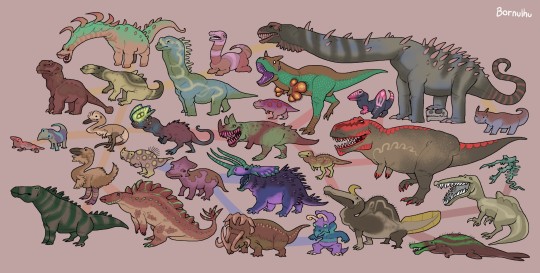
Wacky Evo chart but with dinos only
#creature design#creature#dinosaurs#colorful critters#colorful dinosaurs#speculative evolution#evolutionary tree#sauropods#ceratopsians#spinosaurus#bornulhu art
187 notes
·
View notes
Text
Ever look at the evolutionary tree of primates and when it gets humans you just stop and think "damn, here's where nature really fucked up." looking back at the other primes thinking you should be back there somewhere? Or looking beyond the human branch wondering why your species isn't listed? Or you just stop at the human branch with a big "NOPE! That is SO not me!"?
What goes through your mind? Let me know, I'm a curious little monkeykin!
#paranthropy#paranthrope#alterhuman#therian#otherkin#paranthropic#species dysphoria#therianthropy#therianthrope#monkeykin#apekin#evolution#evolution tree#evolutionary tree
17 notes
·
View notes
Link
uDance, a novel method that builds highly accurate and scalable phylogenetic trees using the divide and conquer approach, has been devised jointly by scientists from the University of California, San Diego, and Arizona State University. Phylogenetic trees are like family trees for all living organisms that help us comprehend how different species are related to each other through evolution. The previous methods presented the drawbacks related to inaccuracy and inefficiency in handling large numbers of organisms. uDance, however, refines different parts of a phylogenetic tree independently and can also build off existing trees. Scientists implemented uDance and successfully generated a tree for around 2,00,00 genomes using 387 marker genes and a huge amount of amino acid data with enhanced accuracy and scalability.
The vast array of species on our planet translates into a large quantity of genetic material to investigate. There exist two methods, one emphasizing numerous genes and fewer organisms, and another focusing on a smaller number of organisms and more genes. The objective is to accumulate a plentiful supply of genes as well as numerous living organisms.
To achieve this goal, scientist Siavash Mirabab and his team have come up with uDance. The divide and conquer strategy employed by uDance breaks down the task into smaller parts and then merges them to build the family tree. This approach not only allows for efficient analysis of a massive amount of genetic data but also enables the updating of the tree as more and more data becomes available.
uDance was successful in creating a family tree for over 1,99,000 organisms using 387 marker genes while being computationally efficient which is a substantial improvement compared to previous methods.
Continue Reading
25 notes
·
View notes
Text
Studies of mitochondrial DNA suggest the Strepsirrhini suborder, containing the ancestors of Madagascar's lemurs, diverged from our own Haplorhini suborder approximately 64 million years ago, which implies that a common ancestor was present before this time, but not a great deal earlier.

"Human Universe" - Professor Brian Cox and Andrew Cohen
#book quotes#human universe#brian cox#andrew cohen#nonfiction#mitochondrial dna#strepsirrhini#madagascar#lemur#haplorhini#evolutionary tree#evolutionary history#hominids#platyrrhini#catarrhini#cercopithecoids#hominoids#hylobatids#spider monkey#macaque#proconsul#siamang#sivapithecus#gibbon#orangutan#ouranopithecus#dryopithecus#gorilla#chimpanzee#human
0 notes
Text
Predatory Bananas: an Evolutionary Horror
(Pls read, I literally spent HOURS on this <3)
A friend sent me the following video about the various potential methods of banana locomotion. It got me thinking. How would a banana move? Naturally, as an autist with a special interest in evolutionary biology, I took the joke a little too far and wrote a whole piece on the matter, analyzing the feasibility of each method and the changes they’d need to evolve in order to achieve them.
(Video courtesy of Burning Onion Animation on TikTok, they make great content, go check them out)
The first and most likely way bananas would move is if banana trees evolved to spread their seeds through their fruits rolling down hills like the morphology of #1 suggests. The only major mutations that need to happen are a more pronounced curve and increased rigidity to facilitate rolling and absorb the impact from falling from the tree. Overall, evolving to this point is relatively straightforward. #1 is the most feasible and realistic answer.
For bananas to develop motility like in #4 is theoretically possible with the right environmental pressures and with enough time, though much more difficult. I see this working in one of two ways. First, they could evolve rigid structures that change shape depending on moisture content, using natural dry/wet cycles to move a little more each time it rains, much like the seeds of Erodium Cicutarium (pictured below). The fruits of the banana tree would most likely evolve to have hooks on the end of said structures, contracting and pulling themselves forward a little each time they dry out, and relaxing and resetting their grip on the soil each time they get wet.
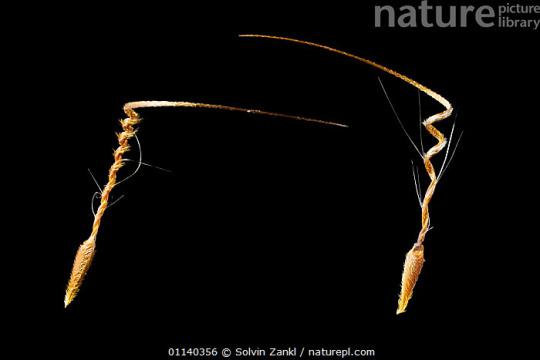
The second way I could see this happening is if they evolved true locomotion. True locomotion in bananas would take at least a few million years to evolve (probably more like tens of millions), and even then, movement would be incredibly slow. There exists a plant called the “walking palm” (socratea exorrhiza, pictured below) that’s capable of “walking” using its roots, but it can only travel about 20 meters per year in ideal conditions, and has the resources of the entire tree at its disposal, not just that of a single fruit.
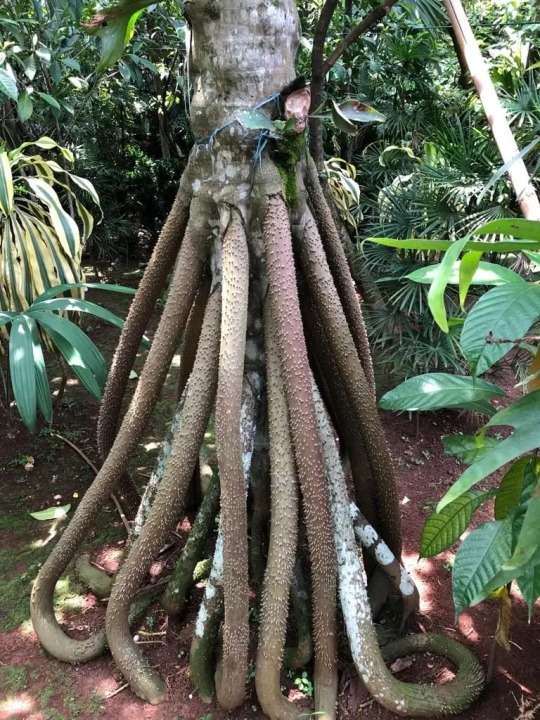
While this is the more likely explanation as to how #4 might happen, it’s not what the video depicts. The video clearly shows a banana dragging itself along like an inchworm, indicating motor cells such as those present in Dionaea Muscipula (venus flytrap, pictured below). Whenever this type of movement in plants occurs, it takes an extreme amount of energy and is generally rather inefficient and slow. In addition to this, the banana is moving its entire mass every time, so it’ll have to move much more slowly to compensate. This means that the banana would probably only be able to travel a few centimeters before decomposing beyond the point of functionality. After a few million more years it’s possible that bananas could evolve to travel as far as several meters after falling off the tree, but the further they go, the more fit each individual fruit needs to be, and the more energy and resources they need. Eventually, it’ll reach a point where the energy expenditure will outweigh the benefit and the fruits will stop evolving to travel any further, which I imagine would plateau somewhere in the 0.5 to 3 meter range. However, the fruits still require a significantly higher amount of energy at this point because they’ve evolved to move autonomously, so trees would likely evolve to produce fewer, but more developed fruits as a result. Overall this is the second most likely way bananas would evolve to move, but the video depicts a time lapse, not footage taken in real time.
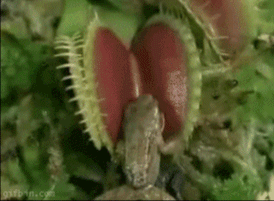
The next most likely option is #2, which is where things start to get much more interesting. At this point we are quickly beginning to leave the territory of the banana being a fruit and stepping closer towards the realm of the banana being its own independent organism. Whether the banana is still a single fruit from a larger tree depends on if the video is stabilized or not. First, let’s assume that the video has automatically stabilized the banana within the frame. This means that the banana is moving erratically and aimlessly, with the goal of simply moving as far from its origin as it can. The most simple form of this would be a ballistic dispersal method in which the banana grows curved and under tension, falling off the tree when ripe. Upon impact, the tension is released and banana extends, springing itself upward and outward with a single bounce. But this isn’t what the video shows either, it depicts clear and repeated movement, again suggesting the presence of motor cells much like those likely found in banana #4. In this case it probably evolved in roughly the same way as banana #4, but works less effectively due to having a less stable method of traveling.
But what if the video ISN’T stabilized, and the banana’s staying upright all on its own? In the video, the banana isn’t just moving along a single plane with one set of motor cells like the Venus flytrap. It’s full on galloping. This requires multiple groups of motor cells working together in a coordinated effort. This banana has real-time sensory input to orient and stabilize itself. This means that the banana has evolved some sort of internal gyroscope, much like our inner ear that helps it determine what up and down is, and more importantly, angular rotation. While plants have been observed reacting to and even predicting stimuli in ways that still baffle scientists to this day, this is far more complex than any plant every discovered throughout human history. Everything here points to something more, perhaps rudimentary intelligence, dare I even say sentience.
This begs the question: is it even a plant anymore? At this stage it’s evolved sensory organs and can move independently. But why? Organisms don’t evolve the ability to move without reason. This could mean one of three things. First, it could have evolved the ability to run as a means of spreading its seeds further. But this can’t be the answer. Moving more slowly would be way more efficient for a banana in terms of energy expenditure, and spreading seeds the old fashioned way is still perfectly viable, so it wouldn’t have evolved that way due to lack of necessity. This brings us to the first legitimate possibility: the banana is prey. If the banana were prey, then the ability to gallop most likely evolved as a means of escaping predators and to avoid being eaten. This is further evidence that the banana has evolved beyond being a humble plant as this goes completely against the purpose of fruits, which evolved to be eaten on purpose. Now, the banana’s goal isn’t to be eaten so that its seeds may be deposited elsewhere, its primary objective is to survive. At this point it’s relatively safe to assume that the banana no longer comes from a tree, and now reproduces through fragmentation, or perhaps even live birth. Its lack of leaves suggest that it’s evolved beyond being an autotroph and relying on photosynthesis. But if it no longer gets nutrients from a tree, how does it subsist? It must be getting its energy from somewhere. The most likely answer to this is that banana is a herbivore, and gets its energy from plant matter, which contains a lot of the same nutrients that the banana recently used to get by growing on a tree. Overall, this is the third most likely way the banana would evolve locomotion.
But what if it isn’t an herbivore? This brings us to the other possibility: the banana is a predator. The banana that concerns me the most is banana #3. While all the other bananas have undergone major changes to their morphology, banana #3 appears to be identical to any regular banana, yet it still moves. The only way that such movement could be possible is if the banana had some sort of internal mechanism that moves its center of mass around rather quickly within its outer shell, which also requires an internal gyroscope for balance. I know what you’re thinking; “but this is an incredibly complex mechanism, wouldn’t it be easier to evolve one of the other ways?” To which the answer is yes, it would. But this raises another question with an even more alarming answer: why didn’t it? The answer lies in the banana’s identical appearance to that of a typical Cavendish. Clearly, looking like an ordinary banana is central to its survival strategy. At this point, it’s evolved well past the point of being a fruit and has become the first of an entirely new kingdom of sentient creatures descended from plants.
According to my estimates from the video, banana #3 is only able to move at a pace of around a tenth of a meter per second, maybe a quarter or half of a meter at the most. This means that it probably didn’t evolve the ability to move as a means of running from predators. Based on the physics in the video, my best guess as to how the banana moves is through the use of mostly hollow internal chambers with a central mass (probably a calcified seed) suspended by tendons that can move in any direction, accelerating the banana in that direction. Here I’ve collaborated with the massively talented @pholidia to bring my ideas to light.
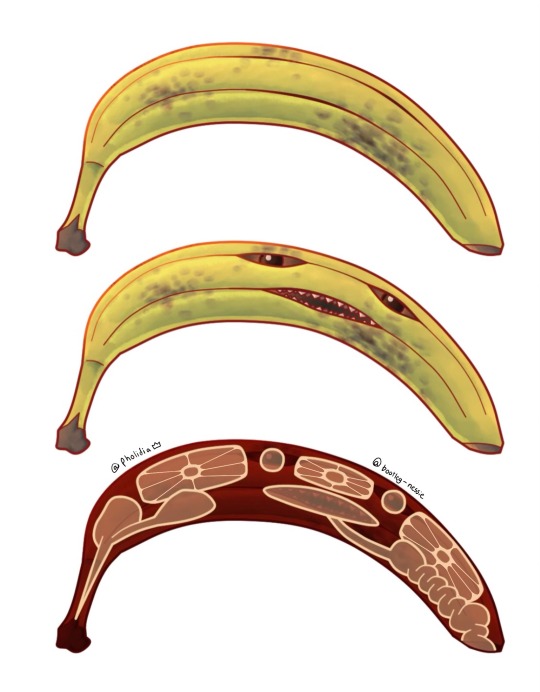
Picture it. You’re a lone banana farmer in South America. You’re out harvesting your crops when you see a single banana on the ground. It looks a little weird and bruised, but still totally edible. “No good in letting perfectly good produce go to waste” you think to yourself as you pick up the banana. You go to peel it when suddenly, you feel a sharp shooting pain through your hand. You drop the banana, then fall to your knees. You look around for the wasp or whatever it was that stung you, but you can’t find anything. You collapse in a heap on the ground, unable to control your body. It’s at this point you notice the banana start to move. “Are… are those teeth?” you think to yourself. At this point the venom has taken full effect. You are alone and completely paralyzed, unable to do anything besides observe the banana as it starts moving towards you. Sharp teeth and beady black eyes are fully visible now. It ambles towards you clumsily, moving almost as if it were being controlled by invisible strings like a marionette. It reaches you and starts to chew. It is at this moment that you discover, much to your horror, that the venom is merely a paralytic, and not an anesthetic. Helpless to the venom, you can do nothing but watch as your blood slowly drains out onto the ground as the creature consumes you. Slowly, your vision begins to fade to black. You pass out, either from the pain or the blood loss, you’re not really too sure. You take one last look at the creature, then you’re gone forever.
#biology#evolutionary biology#evolution#bananas#plants#darwin#science#botany#banana#r/196#196#r/196archive#/r/196#rule#meme#memes#shitpost#shitposting#autism#stem#cool#funny#plant#cooking#trees#fruit#unreality#joke#funny shit#funny post
241 notes
·
View notes
Text
i got a free book

its incredibly dry. i personally am EXTREMELY excited to read it
#biology#this bad boy has a whole chapter on using matrices to construct a phylogenetic tree!!!!!!!!!!!!#siph speaks#i got it at a university open day it was on a pile that said FREE FOR STUDENTS#now i may not technically be students but i did take it#the book says it was owned by somebody who i googled who is an evolutionary bio research scientist which is also very cool#will i be able to understand it though? that is the question!
32 notes
·
View notes
Note
Do psychotropic drugs and/or ritual play a role in any of the blightseed cultures? A pretty broad question, lol
Yeah that’s a very broad question, the answer is about as much as it tends to play roles in real history. Alcohol is pretty ubiquitous (outside of cultures that abstain from intoxicants) and used for a variety of purposes, opioids are commonly used in some parts for pain relief or recreational purposes, stimulants (usually in mild, natural forms) are used to provide extra energy, and hallucinogens are most commonly used as part of a larger religious framework (rather than for recreational purposes). Any more elaborate answer kinda has to be case by case in a certain culture or part of the setting.
I'll just take this as an opportunity to talk about the one established sect that pretty much REVOLVES around psychoactive use. This is the Scholarly Order of the Root, which is a sort of mystery religion + elite community of scholars who currently occupy the Ur-Tree and its forest in the far southern Lowlands (southeast of Imperial Wardin, on the same land mass).
The Ur-Tree is the obligatory Huge Fucking Fantasy Tree (and its surrounding forest). It’s a mass of vegetation about a mile tall and almost as old as Plant Life Itself, its upper branches are primeval plants, which become more modern the nearer they get to the ground (and each 'level' holds tiny ecosystems, some containing descendants of LONG-extinct arthropods/other small animals). Its lowest branches and the surrounding forest are contemporary plant life, and all is connected and protected by an incomparably MASSIVE fungal mycelium network (which is itself a living god).
A lot of the Scholars' more secretive practices revolve around experimentation with substance use with the goal of expanding the Mind and transcending the body to fully connect to the Dreamlands, and they have a supply chain of traders and mercenaries called Rootrunners who traffic substances into the Lowlands. Most of their psychoactive use is in a very intentional capacity and not just like, for fun, but a LOT of them are just straight up addicted to cocaine (in the form of alchemically refined bruljenum, which is used for practical purposes of its stimulant effect during long hours of work).
All known psychoactives are desirable for experimentation (particularly hallucinogens), with each having properties that either allow expansion of the Mind, transcendence of the body, or outright divine communion. Their effects are logged in great detail and interpreted to form the basis of the Scholars' understanding of the natural world and reality itself.
The most important substance is Ur-Root, which is root matter from subterranean levels of the Ur-Tree that have both their own intrinsic psychoactive substances and a very, very high concentration of living god mycelium. The tree root contains DMT and the mycelium has its own wholly unique effects (being an actual living god). They alchemically refine it into a purer, more potent form, and use it to expand beyond the body and directly commune with the Giants, a group of entities they have identified as the only true gods.
An Ur-Root trip starts off with minor visual distortion, which turns into shifting fractals that slowly obscure the vision. Eventually the senses are entirely taken over by a 'tunnel' of rapidly shifting fractals and geometries. In a complete trip, the experiencer gets a sense that they have been pushed through a membrane and entered another realm, finding themselves in a distinct experiential Space.
At this point they may encounter entities which communicate to them in a language impossible to describe but wholly understood. These beings are understood to be the Giants, or at least aspects of the Giants that mortals are capable of comprehending (they often take familiar tutelary forms of the Mantis or the Snake, or appear resembling the same type of sophont that the experiencer is, all composed of ever-shifting geometries). The experiencer often feels a sense of unconditional and endless love from these beings, though the Giants may be more hostile and may appear in the form of the Trickster (usually a cultural figure regarded as malicious, be it an animal or otherwise) in a bad trip.
(^Up until this point, this has mostly just been a DMT 'breakthrough' experience ft. 'machine elves' and the like).
They are then removed from this space and returned to something that feels like the real world, but is nearly unrecognizable. They have a sense of rapidly moving through time, and will usually see 'the spires' towards the beginning, which just so happen to look like this:

(source + some context via Implication- the spires are exactly what this art is depicting)
The experiencer continues to move across an unfathomable amount of time, occasionally 'seeing' other such flashes of unfamiliar landscapes and creatures, and yet also being devoid of all their senses, the 'seeing' is pure, unfiltered experience. There is a sense of interconnectedness with all life, and that one has become the forest (or even Life) itself. The sense of time is wildly distorted, the trip lasts only about 5 minutes but feels like an eternity and is understood as literal hundreds of millions of years.
The experiencer has usually lost any remaining sense of Self and individual consciousness during this phase (in which case this time distortion is usually a neutral or even peaceful experience), but some retain a fraction of their identity, and find themselves trapped and conscious while experiencing what feels like eternity (which can be LIFE-CHANGINGLY distressing, even after the fact).
(^This latter part of the trip is the effects of the Ur-Tree fungus).
The trip ends with a sense of rushing through the ground and back up into one's body, at which point they will abruptly return to their senses and consciousness. The details are then immediately retrieved via interview and recorded in immense detail. The whole experience is understood as having been full comprehension of the Dreamlands, communion with the Giants, and then a tour through the act of creation.
This is done as part of the initiatory practice into the inner mystery-religion of the scholars, and as needed for study by high scholar-priests. It is not taken lightly, both as it is absolute communion with the gods and reality, and in that it can be a very, very difficult experience. People who have gone through this often walk away with a permanently shifted perspective, often in a positive and/or comforting way- a sense of interconnectedness with all life, a peace with the concept of death, seeing less of a point in individual ego and the concept of Self, and comfort in the sense of divine love they (may have) experienced. This heavily influences the philosophy of the Scholars and has had effects by proxy in the religious worldviews of the region.
Details of this experience are closely guarded, and initiates are given absolutely no prior knowledge and expectations for their trip. This is seen as a necessity- their naivety will allow for a true, unfiltered experience, and can be used to gauge whether they should or should not be accepted. Those that have a distinctly bad trip upon initiation may be assumed to have been 'rejected' by the giants and thus denied full priesthood, though this largely depends on How they interpret their distressing trip- those who identify this as a test and harsh lesson in a journey to enlightenment may be accepted (as this is how fully initiated scholar-priests interpret and handle their bad trips).
This inner priesthood is only a small fraction of the Scholarly Order, and its greater function is as a hub of education and repository of knowledge, and Scholar-trained doctors can provide some of the best medical care available in the setting ('best medical care in this setting' only means so much but it's pretty solid, relatively speaking). Only a chosen few Scholars ever get to commune with the Ur-Root, and most of the divine secrets revealed in the process are kept hidden (though they indirectly influence the politics and worldview of the entire order).
#I'm kind of fascinated by the quasi-religious beliefs that have developed around recreational hallucinogen use (ESPECIALLY DMT)#In contrast to like. Uses of DMT-containing substances like ayahuasca for long-established religious purposes#So this concept is basically 'what if a religion was FORMED from pretty much the ground up out of DMT usage'#Like the common 'entities' people encounter in recreational use being identified as the Real Gods and producing a religious worldview#that is mostly rooted in this experience (while still influenced by other cultural factors)#Also the like. Meta going on here is that the fungus is a 'living god' and the oldest one on the planet#It is a VERY rare type of living god that is 'created' by non-sophont (non-sentient even) beings and exists as a mycelial network#that perfectly supports and protects an entire forest. Basically a god for plants. It is so deeply interconnected with its forest that the#usual power sophont belief would have over it has basically zero influence. This is absolutely the closest thing to A God in canon.#(While still not being a Creator/sapient/or even supernatural within the framework of this reality. Just VERY unique.)#The Ur-Tree has always been above water and grows very very slowly over the course of millenia by kind of 'pulling up' plant life from#the ground (so you see ancient long extinct plants in its higher branches and contemporary plants close to/on the ground)#The mycelium helps shield and feed extinct plant life that could not otherwise survive in the contemporary environment#And the forest is big enough to produce its own weather (it is a rainforest and has been ever since the capacity for rainforests Existed)#It's not really a tree at all in any normal sense but an amalgam of thousands of types of plants-#Some growing on top of others and some interwoven beyond any distinction. It does form a superficially treelike structure#(mostly in order to physically support its own mass) with a very wide 'trunk' and massive 'roots' (which end in actual roots).#It feeds on its own perpetually shedding and decaying 'body' and any animal life that dies in the forest is VERY rapidly#decayed and absorbed by the mycelial network (to the point that many large scavengers cannot survive in this forest)#(If you kill a cow and leave it on the ground for just 1/2 hour you'll see little strands of mycelium already growing up around it)#The fungus fruits and spores on a very infrequent basis (scale of ten-thousands of years) which causes the forest to very slowly spread#Fortunately this isn't really an existential threat because the spread is VERY slow (even on a geological scale) and the fungus#itself is rather mundane in nature and cannot usually compete against established fungal networks in other places.#Though there are little Ur-Tree mycelium groves and woodlands in other parts of the world that may (over untold millennia)#generate their own Ur-Trees (there's already a few but they are all MUCH smaller and not readily recognized as the same thing)#WRT THE TRIP:#Most of what I'm describing is a DMT trip but consumption of high doses of Ur-Tree mycelium has both mundane psychoactive effects#and IS kind of the person experiencing the fungus' entire lifetime and seeing flashes of the world's actual evolutionary history.#The amount of material knowledge that can be accurately gleaned from this this is VERY limited though.
75 notes
·
View notes
Text

30 Day Pokémon Drawing Challenge Day 10: Favorite Pikachu Clone
Tbh, I'm not a fan of pikachu nor it's clones in general, but dedenne is kinda cute.
#defense#pkmnart#invisible art#I actually like pichu and (alolan) raichu quite a bit#but they're not clones as they're part of it's evolutionary tree#neither is minikyu because it chooses to look like pikachu when it doesn't have to
28 notes
·
View notes
Note
is Falcon the only cat with powers or do a few of the others have them
About half the clan has them.
Silk, Beetle: sensitive to the afterlife
Dew, unnamed kit: can see the dead
Valley: impossibly strong
Crane: can only see the world of the Takers
Rattle: cannot freeze
Jay: impressive bursts of speed
Epilogue: can hold his breath for an obscenely long time
Falcon: fearless
Unnamed kit2: huger than natural stamina
Unnamed kit3: darken
#askjon#off the top of my head#if I forget about anyone whoops#AGAIN gifts are not some all powerful things#they're evolutionary attempts at survival gifted to them by their very cursed homelands#there's just a big a chance someone doesn't get a gift as there is they do#G1 developed new gifts#G2 and so on get gifts that are genetically passed down and somewhere close in their family tree#they're genuinely not overly important to the plot or story#just some fun stuff for me to create more trauma /hj
42 notes
·
View notes
Text
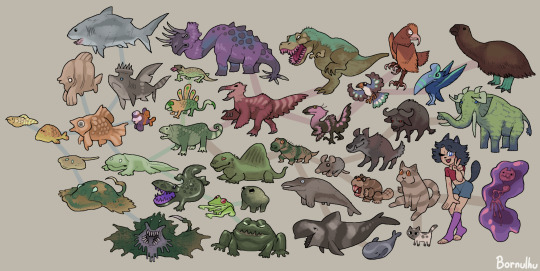
Wacky evolutionary tree
#creature design#monster design#original creature#evolution#speculative evolution#evolutionary tree#dinosaurs#catboy#colorful critters#bornulhu art
171 notes
·
View notes
Text
Random idea: what if the reason most races in tensura have fallen from grace in the cardinal world is because the densisty of ambient magicules was eviscerated when Veldanava and his first creations either all died or disappeared, leading to monsters and humans evolving into forms with lower to no magicule intake requirements
#that time i got reincarnated as a slime#tensei shitara slime datta ken#tensura#ttigraas#veldanava#That time I analyzed a fictional series' evolutionary trees#rimuru
16 notes
·
View notes
Text
me: hm i think i should go to bed
my brain: do crossbreeds exist in httyd
me: oh fuck
#like. are they too different species for it to work?#would it be like mules where it works but the offspring is infertile#maybe it would only work between the same class of dragon?#what are the dragons evolutionary trees?#if someone made the book from httyd i would buy it and read it fishlegs style
7 notes
·
View notes
Text
I love when people apply their subjects of study/work to a narrow part of tes lore. One of my favorite parts of this fandom
#learn new things AND engage with special interest!! what could be better!!!!!#anyway shout out to that soil post#and to the food posts i see form time to time#there is a phylogenetic tree and evolutionary history of the morrowind/skyrim beasties in my head that i need to put into the world someday#also i have an idea for unique soul gem powered and dwemer sewing machines but im not good enough at designed machinery for that#mine#tes#the elder scrolls#tesblr
44 notes
·
View notes
Text
despite its name, cyclizar is not a lizard pokémon. it is actually an archosaur, most closely related to bird and crocodilian pokémon. its prehistoric ancestors are believed to have been feathered and capable of gliding, though this trait was lost over the millions of years of evolution that gave us our modern motorcycle buddies.
#pokémon#pkmn irl#cyclizar#koraidon#< kinda#[i do not know the exact evolutionary tree of archosaurs to place this thing further than this.]
30 notes
·
View notes
Text
"An international team of scientists have discovered a huge spike in radiocarbon levels 14,300 years ago by analyzing ancient tree-rings found in the French Alps.
The radiocarbon spike was caused by a massive solar storm, the biggest ever identified.
A similar solar storm today would be catastrophic for modern technological society—potentially wiping out telecommunications and satellite systems, causing massive electricity grid blackouts, and costing us billions of pounds.
The academics are warning of the importance of understanding such storms to protect our global communications and energy infrastructure for the future."
continue reading article
#sun#cycles#solar storm#solar energy#astronomy#space#solar system#earth#nature#trees#history#energy#radiation#earth atmosphere#radiocarbon#science#technology#discovery#evolutionary stages#electric universe
18 notes
·
View notes
Text

whats this guys deal
#i dont think its a native tree cause most aus native trees have evolutionary traits which help them absorb LESS sunlight#but the fact that this guys branches and leaves go straight up . like the branches fan out but then grow vertically#that seems like a trait to collect more sunshine#idk tho . idk
12 notes
·
View notes